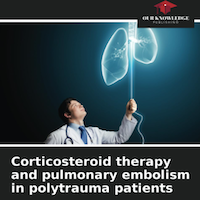Tag: study
Impact of Extended-course Oral Nirmatrelvir/Ritonavir in Established Long COVID
Extended courses of nirmatrelvir/ritonavir may have meaningful benefits for some people with Long COVID but not others. We encourage researchers to study how and why nirmatrelvir/ritonavir benefits some and what course length... read more
Prediction of AKI in ICU Patients Based on Interpretable Machine Learning
The machine learning model described in this study is capable of accurately predicting the onset of AKI in ICU patients up to 24 hours in advance. Validated within the MIMIC-IV and MIMIC-III databases, the model demonstrates... read more
Decision Support Tool in the Prehospital Setting for Acute Chest Pain
Using the Atellica VTLi in the EMS setting for the analysis of troponin I in acute chest pain patients is feasible. However, the instruments are unfamiliar for most EMS personnel, and a break-in period should be allowed for... read more
Fluid Bolus Therapy with 20% Albumin vs. Crystalloid-based Regimen
In this trial involving adult patients undergoing cardiac surgery with cardiopulmonary bypass, 20% albumin fluid bolus therapy (FBT) compared to crystalloid FBT did not decrease the occurrence of acute kidney injury (AKI).... read more
New Insights on CRRT for ARDS
In recent times, the applications of continuous renal replacement therapy (CRRT) beyond kidney‐related conditions have been progressively increasing, and its implementation in randomized controlled trials (RCTs) specifically... read more
Single-use vs. Multiple-use Endotracheal Suction Catheters Flushed with Chlorhexidine in Mechanically Ventilated ICU Patients
The aim of this feasibility randomized controlled trial (fRCT) is to assess the practicality and impact of using single-use versus multiple-use endotracheal suction catheters flushed with chlorhexidine on the incidence of... read more
Immune Cell-Based vs. Albumin-Based Ratios as Outcome Predictors in Critically Ill COVID-19 Patients
This study aimed to assess the prognostic value of an array of biomarkers regarding the likelihood of a lethal outcome in critically ill COVID-19 patients. We took advantage of the opportunity to classify them into immune... read more
Mechanical Ventilator-Associated Pneumonia in the COVID-19 Pandemic Era
The most common pathogens isolated in our ventilator-vssociated pneumonia (VAP) patients were Acinetobacter spp., Pseudomonas aeruginosa, Klebsiella pneumoniae, and Staphylococcus aureus. Resistance to the major classes... read more
Atrial Fibrillation Status and Associations with Adverse Clinical Outcomes in COVID-19 Patients
COVID-19 patients with atrial fibrillation (AF) are at high risk of adverse clinical outcomes. Such patients may need increased surveillance and consideration for early anticoagulation. Patients admitted with COVID-19... read more
Heparin-binding Protein Predicts Bacterial Infection in Severe Polytrauma Patients
In patients with severe polytrauma, heparin-binding protein may predict bacterial infection. Combining heparin-binding protein, PCT, and neutrophils may improve bacterial infection prediction. HBP provides a referenceable... read more
7-day Fluid Balance Associated with Poor Outcomes
The net fluid balance in patients with sepsis 7 days following ICU administration was significantly related to mortality during hospitalization. Specifically, a 7-day fluid balance > 5,240 mL was associated with poor... read more
Establishment and Validation of a Risk Prediction Model for Sepsis-Associated Liver Injury in ICU Patients
This novel nomogram effectively predicts SALI risk in sepsis patients by integrating readily available clinical parameters. While external validation is needed, the model shows promise as a practical tool for early risk stratification,... read more
ECMO Use in Pediatric Trauma: National Trauma Data Bank Report
The findings of this study support the increasing use of extracorporeal membrane oxygenation (ECMO) as a potentially effective intervention for pediatric trauma patients, including those with TBI. While ECMO provides... read more
Lactic Acidosis with Metformin Accumulation in the ICU
Metformin-associated lactic acidosis (MALA) in ICUs often follow acute dehydration or infection, and these high-risk situations must be signals to prevent this serious ADR. Specific education programs for physicians and... read more
Increased Lactate Dehydrogenase to Albumin Ratio Associated with Short-term Mortality in Septic ICU Patients
Elevated lactate dehydrogenase to albumin ratio (LAR) was found to be significantly associated with an increased risk of all-cause mortality at 28 and 90 days in septic patients. LAR was suggested to be promising biomarker... read more
The Role of Rotational Thromboelastometry in Early Detection of the Hemostatic Derangements in Neonates with Systemic Candida Infection
Rotational thromboelastometry (ROTEM) parameters revealed a hypocoagulable profile in neonates during the early stages of SCI, which is also associated with disease severity. The results of this study highlight the need for... read more
Bedside Tunneled Dialysis Catheter Program Development and Implementation
The placement of ultrasound guided tunneled dialysis catheters at the bedside following a pre-procedural evaluation of the right jugular, brachiocephalic, and femoral veins is a safe option resulting in expedited patient... read more
ECMO vs. Cardiopulmonary Bypass in Lung Transplantation
Extracorporeal membrane oxygenation (ECMO) offers perioperative advantages in lung transplantation, reducing postoperative complications, one-year mortality, and recovery time compared to CPB. However, the longer total ischemic... read more
Plasma Proteome Temporal Changes Associated with Sepsis Mortality
Our proteomics approach revealed significant associations between changes in the plasma proteome within the first days of sepsis and mortality as well as disease severity. We identified and characterised the underlying... read more
Corticosteroid Therapy and Pulmonary Embolism in Polytrauma Patients
Pulmonary embolism is a frequent complication in polytrauma patients. The aim of our study was to evaluate the effect of low-dose corticosteroid therapy on the incidence of pulmonary embolism (PE) in polytrauma patients.... read more

Succinate-containing Crystalloid Solution in Correction of COVID-19-associated Endotheliopathy
The use of a succinate-containing infusion solution in patients with a new coronavirus infection promotes a more rapid and sustainable correction of COVID-19-associated endotheliopathy, which, in turn, is manifested by a... read more
Ketamine May Reduce Opioid Requirements Following Cardiac Surgery
Ketamine may be a reasonable choice for postoperative cardiac surgery analgesia and may reduce the need for opioids on discharge, and possibly during admission. This study is a single center, retrospective, observational,... read more









